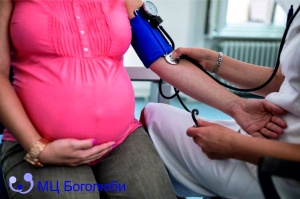Low Blood pressure is a condition in which resting blood pressure values are below normal. In numerical terms, normal blood pressure is in the range of values from 90/60 mm Hg . Art. The first value is the so-called systolic or maximum pressure , and the second - diastolic or the minimum.
The severity of hypotension Indicators
Hypotension or mild low blood pressure Less than 90/60 mmHg , but above 60/40 mmHg . - mild degree
Hypotension or moderate low blood pressure Less than 60/40 mmHg , but above 50/33 mmHg . - intermediate level.
Hypotension or severe low blood pressure Less than 50/33 mmHg . - severe degree
Low blood pressure during pregnancy - a very common phenomenon, which is strictly dependent on the characteristic hormonal changes of this particular period of a woman's life. It is caused by the natural increased production of the hormone progesterone. In essence, this is a consequence of the physiological mechanism, without which adequate development of the fetus could not occur.
When does blood pressure start to drop? In pregnant women, blood pressure tends to progressively decrease from the very beginning of pregnancy. At 24 weeks of gestation, the magnitude of the fall in blood pressure is about 5-10 points for systolic blood pressure and just over 10 points for diastolic blood pressure. Thus, in essence, it is almost always a small decrease.
This condition usually continues until the end of the second trimester of pregnancy. After this period, blood pressure begins to gradually increase until it returns to its normal prenatal levels.
What are the risk factors for hypotension?
The drop in blood pressure during pregnancy in itself is a very predictable phenomenon. However, there are circumstances where both a woman and her gynecologist must consider during a possible pregnancy. Among them, the main ones are: constitutional hypotension; hormonal diseases ( Addison's disease , diabetes mellitus); tendency to anemia; low dietary intake of folic acid and vitamin B12.
What to expect from lowering blood pressure?
While low blood pressure during pregnancy can even be valuable for women with chronic hypertension, for many patients with normal blood pressure and for most women with symptoms of hypotension, the drop in blood pressure can be a problem. Among these problems, the most common are: weakness, dizziness, fainting, visual disturbances, nausea, headache and fatigue. The peculiarity of symptoms from weakness to blurred vision is that they are pronounced when changing the position of the body from a sitting or lying position to a standing position.
What can aggravate symptoms of low BP?
With a sudden transition from a sitting or lying position to a standing position, the venous system of the legs is not able to immediately return all the trapped blood and there is an inevitable decrease in the return of blood to the heart and, as a result, the appearance of weakness, dizziness, visual impairment and fainting. Hypoglycemia and dehydration lead to a decrease in the total volume of blood circulating in the body and also provoke hypotension.
Eating too large portions: After a meal, BP physiologically decreases due to a large blood flow to the digestive system and a decrease in the blood supply to other organs of the body. It aggravates hypotension and alcohol due to its vasodilating effect.
When to see a doctor?
Some experts hypothesize that a significant drop in a pregnant woman's blood pressure may put her at risk for low birth weight and even fetal death. Low blood pressure during pregnancy requires medical attention if it is accompanied by: severe headaches, prolonged vomiting, shortness of breath, chest pain, a strong increase in heart rate, numbness in any part of the body. With similar problems you can apply to MC " Bogolyuby " . In most cases, low blood pressure during pregnancy does not require special care and treatment, but only some precautions that are useful in controlling the symptoms of hypotension.



















